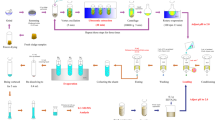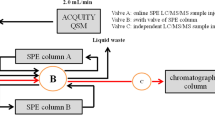Abstract
With the pandemic of COVID-19, the application of quaternary ammonium compounds (QACs), which can be used in SARS-CoV-2 disinfection products, has increased substantially. QACs cumulated in sewer system are ultimately deposited and enriched in sludge. QACs in the environment can adversely affect human health and the environment. In this study, a liquid chromatography–mass spectrometry method was established for the simultaneous determination of 25 QACs in sludge samples. Ultrasonic extraction and filtration of the samples was performed using a 50 mM hydrochloric acid–methanol solution. The samples were separated by liquid chromatography and detected in multiple reaction monitoring mode. The matrix effects of the sludge on the 25 QACs ranged from − 25.5% to 7.2%. All substances showed good linearity in the range of 0.5–100 ng/mL, with all determination coefficients (R2) greater than 0.999. The method detection limits (MDLs) were 9.0 ng/g for alkyltrimethylammonium chloride (ATMAC), 3.0 ng/g for benzylalkyldimethylammonium chloride (BAC), and 3.0 ng/g for dialkyldimethylammonium chloride (DADMAC). The spiked recovery rates were in the range of 74–107%, while the relative standard deviations were in the range of 0.8–20.6%. Considering its sensitivity, accuracy, and easy operation, the proposed method in this study was used to determine 22 sludge samples collected from a comprehensive wastewater treatment plant. The results showed that the concentrations of ΣATMACs, ΣBACs, and ΣDADMACs were 19.684, 3.199, and 8.344 μg/g, respectively. The main components included ATMAC-C16, ATMAC-C18, ATMAC-C20, ATMAC-C22, BAC-C12, and DADMAC-C18:C18, with concentrations exceeding 1.0 μg/g. The concentration relationships of different components in the congeners showed that some components were of similar origin.
Graphical abstract







Similar content being viewed by others
Explore related subjects
Discover the latest articles and news from researchers in related subjects, suggested using machine learning.Data availability
The data that support the findings of this study are available from the corresponding author upon reasonable request.
References
P.A. Lara-Martín, X. Li, R.F. Bopp, B.J. Brownawell, Environ Sci Technol. (2010). https://doi.org/10.1021/es101169a
C.P. Gerba, Appl Environ Microbiol. (2015). https://doi.org/10.1128/aem.02633-14
U. Tezel, S.G. Pavlostathis, Curr Opin Biotechnol. (2015). https://doi.org/10.1016/j.copbio.2015.03.018
C. Zhang, F. Cui, G.M. Zeng, M. Jiang, Z.Z. Yang, Z.G. Yu et al., Sci Total Environ. (2015). https://doi.org/10.1016/j.scitotenv.2015.03.007
A. Meireles, E. Giaouris, M. Simões, Food Res Int. (2016). https://doi.org/10.1016/j.foodres.2016.01.021
P. I. Hora, S. G. Pati, P. J. Mc Namara, Arnold W. A., Environ Sci Technol Lett. (2020)
H. Dewey, J.M. Jones, M.R. Keating, J. Budhathoki-Uprety, ACS Chem Health Saf. 29(1), 27–38 (2022)
U. S. E. P. Agency: List N: Products with Emerging Viral Pathogens AND Human Coronavirus claims for use against SARS-CoV-2. https://www.epa.gov/sites/default/files/2020-06/documents/sars-cov2_listn_06122020.pdf. Accessed 12 June 2020.
N. Baker, A.J. Williams, A. Tropsha, S. Ekins, Pharm Res. (2020). https://doi.org/10.1007/s11095-020-02842-8
A. Suthar, A. Gopalakrishnan, C. Maji, R.K. Dahiya, R. Kumar, S. Kumar, Int J Parasitol Drugs Drug Resist. (2022). https://doi.org/10.1016/j.ijpddr.2022.07.001
O. Alonso-González, F. Nava-Alonso, C. Jimenez-Velasco, A. Uribe-Salas, Miner Eng. (2013). https://doi.org/10.1016/j.mineng.2012.11.013
Q. Liu, M. Zhang, Y. Cao, B. Peng, J.B. Barvor, Sep Purif Technol. (2021). https://doi.org/10.1016/j.seppur.2021.119057
L. Fang, L. Ding, W. Ren, H. Hu, Y. Huang, P. Shao et al., J Hazard Mater. (2021). https://doi.org/10.1016/j.jhazmat.2021.125829
A.C. Chiaia-Hernandez, M. Krauss, J. Hollender, Environ Sci Technol. (2013). https://doi.org/10.1021/es303888v
T. Ruan, S. Song, T. Wang, R. Liu, Y. Lin, G. Jiang, Environ Sci Technol. (2014). https://doi.org/10.1021/es4050314
I. Mulder, J. Siemens, V. Sentek, W. Amelung, K. Smalla, S. Jechalke, Rev Environ Sci Bio/Technol. (2018). https://doi.org/10.1007/s11157-017-9457-7
G. Zheng, E. Schreder, S. Sathyanarayana, A. Salamova, J Expo Sci Environ Epidemiol. (2022). https://doi.org/10.1038/s41370-022-00439-4
A. Luz, P. DeLeo, N. Pechacek, M. Freemantle, Regul Toxicol Pharmacol. (2020). https://doi.org/10.1016/j.yrtph.2020.104717
N. Migueres, C. Debaille, J. Walusiak-Skorupa, A. Lipińska-Ojrzanowska, X. Munoz, V. van Kampen et al., J Allergy Clin Immunol Pract. (2021). https://doi.org/10.1016/j.jaip.2021.04.041
T.C. Hrubec, R.P. Seguin, L. Xu, G.A. Cortopassi, S. Datta, A.L. Hanlon et al., Toxicol Rep. (2021). https://doi.org/10.1016/j.toxrep.2021.03.006
C. Díez, M. Feinberg, A.S. Spörri, E. Cognard, D. Ortelli, P. Edder et al., Food Anal Methods. (2016). https://doi.org/10.1007/s12161-015-0216-5
P.C. DeLeo, C. Huynh, M. Pattanayek, K.C. Schmid, N. Pechacek, Ecotoxicol Environ Saf. (2020). https://doi.org/10.1016/j.ecoenv.2020.111116
European Pharmacopoeia, 8th Ed. European Pharmacopoeia Commission.
R.B. Taylor, S. Toasaksiri, R.G. Reid, J Chromatogr A. (1998). https://doi.org/10.1016/s0021-9673(97)00986-2
J. Zabielska-Matejuk, K. Czaczyk, Wood Sci Technol. 40(6), 461–475 (2006)
B. Thalhamer, A.S. Guntner, W. Buchberger, J Anal Appl Pyrolysis. (2022). https://doi.org/10.1016/j.jaap.2022.105447
P.K. Thai, J.W. O’Brien, A.P.W. Banks, G. Jiang, J. Gao, P.M. Choi et al., Sci Total Environ. (2019). https://doi.org/10.1016/j.scitotenv.2019.03.231
V.G. Amelin, D.S. Bol’shakov, Pharm Chem J. (2020). https://doi.org/10.1007/s11094-020-02216-9
A. Lazofsky, C. Doherty, P. Szary, B. Buckley, Emerg Contam. (2022). https://doi.org/10.1016/j.emcon.2022.06.005
T. Boogaerts, L. Jurgelaitiene, C. Dumitrascu, B. Kasprzyk-Hordern, A. Kannan, F. Been et al., Sci Total Environ. (2021). https://doi.org/10.1016/j.scitotenv.2021.145914
W. Zhou, S. Yang, P.G. Wang, Bioanalysis (2017). https://doi.org/10.4155/bio-2017-0214
S.G. Pati, W.A. Arnold, Environ Sci Process Impacts. (2020). https://doi.org/10.1039/c9em00554d
Acknowledgements
This research was funded by the Municipal Financial Research Project of Beijing Academy of Science and Technology, grant number 11000022T000000445296, the Municipal Financial Research Project of Beijing Academy of Science and Technology, Grant No. 11000022T000000468149 and National Natural Science Foundation of China, Grant No. 72061137007.
Author information
Authors and Affiliations
Corresponding authors
Ethics declarations
Conflict of interest
The authors declare no conflict of interest.
Rights and permissions
Springer Nature or its licensor (e.g. a society or other partner) holds exclusive rights to this article under a publishing agreement with the author(s) or other rightsholder(s); author self-archiving of the accepted manuscript version of this article is solely governed by the terms of such publishing agreement and applicable law.
About this article
Cite this article
Shu, M., Ding, D., Asihaer, Y. et al. Determination of 25 quaternary ammonium compounds in sludge by liquid chromatography–mass spectrometry. ANAL. SCI. 39, 1435–1444 (2023). https://doi.org/10.1007/s44211-023-00354-0
Received:
Accepted:
Published:
Issue Date:
DOI: https://doi.org/10.1007/s44211-023-00354-0
Keywords
Profiles
- Yifei Hu View author profile




